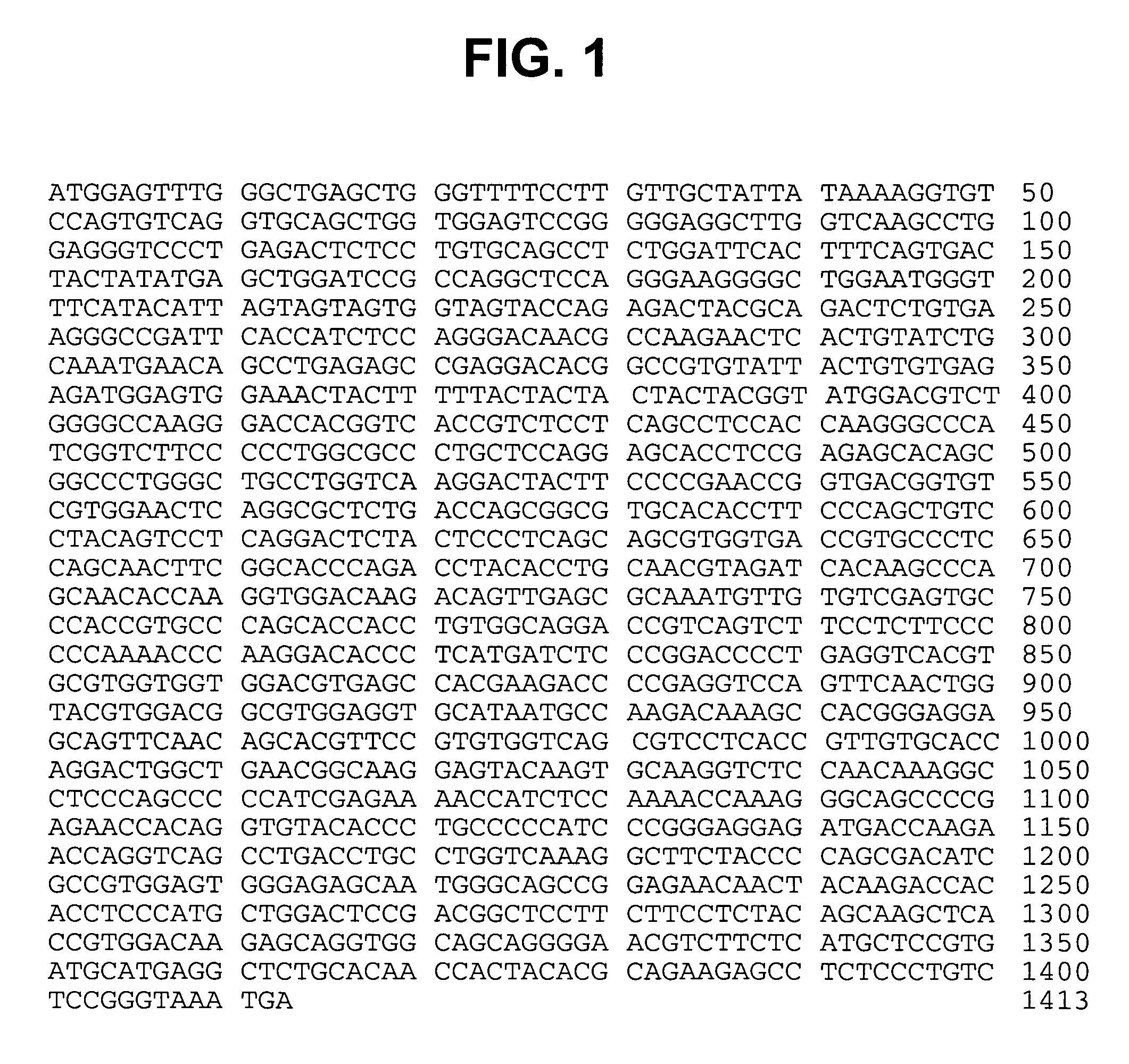Modified human IGF-IR antibodies
a technology of human igf-ir and igfir, which is applied in the field of modified human igf-ir antibodies, can solve the problems of increased risk of common cancer in individuals with “high normal” levels of igf-i
- Summary
- Abstract
- Description
- Claims
- Application Information
AI Technical Summary
Benefits of technology
Problems solved by technology
Method used
Image
Examples
example i
Generation of Hybridoma Producing Anti-IGF-IR Antibody
[0156]The antibody of the invention was prepared, selected, and assayed as follows:
[0157]Eight to ten week old XENOMICE™ were immunized intraperitoneally or in their hind footpads with either the extracellular domain of human IGF-IR (10 μg / dose / mouse), or with 3T3-IGF-IR or 300.19-IGF-IR cells, which are two transfected cell lines that express human IGF-IR on their plasma membranes (10×106 cells / dose / mouse). This dose was repeated five to seven times over a three to eight week period. Four days before fusion, the mice received a final injection of the extracellular domain of human IGF-IR in PBS. Spleen and lymph node lymphocytes from immunized mice were fused with the non-secretory myeloma P3-X63-Ag8.653 cell line and were subjected to HAT selection as previously described (Galfre and Milstein, Methods Enzymol. 73:3-46, 1981). A hybridoma, 2.12.1, producing monoclonal antibodies specific for IGF-IR was selected for further study ...
example ii
Antibody-mediated Blocking of IGF-I / IGF-IR Binding
[0163]ELISA experiments were performed to quantitate the ability of the antibody of the invention to inhibit IGF-I binding to IGF-IR in a cell-based assay. IGF-IR-transfected NIH-3T3 cells (5×104 / ml) were plated in 100 μl of DMEM high glucose media supplemented with L-glutamine (0.29 mg / ml), 10% heat-inactivated FBS, and 500 μg / ml each of geneticin, penicillin and streptomycin in 96-well U-bottom plates. The plates were incubated at 37° C., 5% CO2 overnight to allow cells to attach. The media was decanted from the plates and replaced with 100 μl fresh media per well. For testing, the antibody was diluted in assay media (DMEM high glucose media supplemented with L-glutamine, 10% heat-inactivated FBS, 200 μg / ml BSA and 500 μg / ml each of geneticin, penicillin and streptomycin) to the desired final concentration. All samples were performed in triplicate. The plates were incubated at 37° C. for ten minutes. The [125I]-IGF-I was diluted to...
example iii
Antibody-mediated Inhibition of IGF-I-induced Phosphorylation of IGF-IR
[0166]ELISA experiments were performed in order to determine whether the antibody of this invention was able to block IGF-I-mediated activation of IGF-IR. IGF-I-mediated activation of IGF-IR was detected by decreased receptor-associated tyrosine phosphorylation.
ELISA Plate Preparation
[0167]ELISA capture plates were prepared by adding 100 μl blocking buffer (3% bovine serum albumin [BSA] in Tris-buffered saline [TBS]) to each well of a ReactiBind Protein G-coated 96-well plates (Pierce). The plates were incubated by shaking for 30 minutes at room temperature. The rabbit pan-specific SC-713 anti-IGF-IR antibody (Santa Cruz) was diluted in blocking buffer to a concentration of 5 / μg / ml. 100 μl diluted antibody was added to each well. The plates were incubated with shaking for 60-90 minutes at room temperature. The plates were washed five times with wash buffer (TBS+0.1% Tween 20) and the remaining buffer was blotted...
PUM
| Property | Measurement | Unit |
|---|---|---|
| W/W | aaaaa | aaaaa |
| W/W | aaaaa | aaaaa |
| W/W | aaaaa | aaaaa |
Abstract
Description
Claims
Application Information
 Login to View More
Login to View More - R&D
- Intellectual Property
- Life Sciences
- Materials
- Tech Scout
- Unparalleled Data Quality
- Higher Quality Content
- 60% Fewer Hallucinations
Browse by: Latest US Patents, China's latest patents, Technical Efficacy Thesaurus, Application Domain, Technology Topic, Popular Technical Reports.
© 2025 PatSnap. All rights reserved.Legal|Privacy policy|Modern Slavery Act Transparency Statement|Sitemap|About US| Contact US: help@patsnap.com



